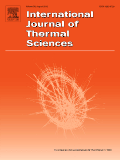
INTERNATIONAL JOURNAL OF THERMAL SCIENCES
Scope & Guideline
Innovating research in thermodynamics and engineering.
Introduction
Aims and Scopes
- Thermal Management and Optimization:
Research focusing on the design and optimization of systems for effective thermal management, including heat exchangers, cooling systems, and thermal insulation materials. - Heat Transfer Mechanisms:
Studies investigating various heat transfer mechanisms, including conduction, convection, and radiation, particularly in complex geometries and materials. - Phase Change Materials and Thermal Storage:
Exploration of phase change materials (PCMs) for thermal energy storage applications, including their thermal properties, performance enhancements, and integration into various systems. - Nanofluids and Advanced Coolants:
Research on the application of nanofluids and other advanced cooling solutions in enhancing heat transfer characteristics in thermal systems. - Thermal Dynamics in Energy Systems:
Analysis of thermal dynamics in energy systems, including thermal efficiency, renewable energy applications, and the thermal behavior of materials under operational conditions. - Computational and Experimental Techniques:
Utilization of computational fluid dynamics (CFD), lattice Boltzmann methods, and experimental techniques to investigate thermal phenomena across various applications. - Thermal Properties of Materials:
Investigations into the thermal properties of new and existing materials, including thermal conductivity, heat capacity, and their effects on energy systems.
Trending and Emerging
- Heat Transfer in Micro and Nanoscale Systems:
There is a significant increase in research addressing heat transfer at micro and nanoscale levels, driven by the need for efficient thermal management in electronics and energy systems. - Thermal Energy Storage Technologies:
Research on advanced thermal energy storage technologies, particularly using phase change materials and novel configurations, is rapidly gaining attention. - Thermal Management in Renewable Energy Systems:
The integration of thermal management strategies in renewable energy systems, such as solar thermal applications and geothermal energy, is an emerging focus area. - Machine Learning and AI in Thermal Sciences:
The application of machine learning and AI techniques for predicting thermal behaviors, optimizing thermal systems, and enhancing heat transfer processes is on the rise. - Multiphase Flow and Heat Transfer Analysis:
There is a growing interest in the study of multiphase flow and its impact on heat transfer in various applications, reflecting the complexity of real-world systems. - Advanced Materials for Thermal Applications:
Research on novel materials, including nanocomposites and metamaterials, designed for improved thermal performance and efficiency is increasingly prevalent.
Declining or Waning
- Conventional Refrigeration Technologies:
The journal has seen a reduction in publications related to conventional refrigeration technologies, as research increasingly focuses on alternative cooling methods and eco-friendly refrigerants. - Basic Thermodynamic Cycles:
There is a noticeable decline in studies solely centered on traditional thermodynamic cycles, as researchers are now exploring more complex, hybrid, and innovative thermodynamic systems. - Single-Phase Heat Transfer Studies:
Research focusing exclusively on single-phase heat transfer phenomena has diminished, likely due to the growing interest in multi-phase systems and their applications in advanced thermal management. - Traditional Heat Exchanger Designs:
Publications on conventional designs of heat exchangers are decreasing as novel designs and materials are preferred for enhanced performance and efficiency. - Basic Heat Transfer Coefficient Measurements:
The focus on basic experimental methodologies for measuring heat transfer coefficients has waned, with an increased emphasis on advanced measurement techniques and computational approaches.
Similar Journals
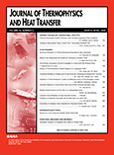
JOURNAL OF THERMOPHYSICS AND HEAT TRANSFER
Illuminating the Path of Thermophysical DiscoveriesJOURNAL OF THERMOPHYSICS AND HEAT TRANSFER, published by the American Institute of Aeronautics and Astronautics, serves as a vital platform for the dissemination of cutting-edge research in the fields of thermophysics and heat transfer. With an ISSN of 0887-8722 and an E-ISSN of 1533-6808, this journal has been pivotal in enhancing our understanding of heat transfer mechanisms since its inception in 1987, continuing through 2024. It occupies a noteworthy position in various academic categories, boasting Q2 rankings in both Fluid Flow and Transfer Processes and Mechanical Engineering, reflecting its significant contribution to the engineering and physical sciences community. Although it currently does not offer Open Access options, the journal’s repository of rigorous peer-reviewed articles remains accessible to researchers, professionals, and students eager to expand their knowledge and apply innovative findings in aerospace, condensed matter physics, and planetary sciences. Emphasizing both theoretical and experimental approaches, the JOURNAL OF THERMOPHYSICS AND HEAT TRANSFER remains an indispensable resource for advancing the frontiers of engineering and applied sciences.
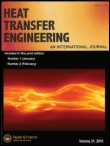
HEAT TRANSFER ENGINEERING
Exploring the frontiers of heat transfer and engineering excellence.HEAT TRANSFER ENGINEERING is a leading international journal published by Taylor & Francis Inc, dedicated to advancing the field of heat transfer and thermal engineering. With a strong focus on the key aspects of Condensed Matter Physics, Fluid Flow and Transfer Processes, and Mechanical Engineering, this journal covers a comprehensive range of topics from experimental studies to theoretical analysis, aiming to foster innovative research and practical applications. Since its inception in 1979 and continuing through 2024, the journal has established itself as an essential resource for researchers and industry professionals alike, reflected in its solid rankings within Scopus—holding a Q2 quartile classification in multiple engineering disciplines. Although not open access, the journal ensures broad accessibility through institutional subscriptions, making cutting-edge research readily available. With its rigorous peer-review process and commitment to quality, HEAT TRANSFER ENGINEERING plays a crucial role in shaping the future of thermal management solutions and engineering practices.
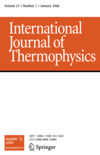
INTERNATIONAL JOURNAL OF THERMOPHYSICS
Unveiling the Science of Heat and MatterInternational Journal of Thermophysics, published by Springer/Plenum Publishers, is a premier platform for the dissemination of high-quality research in the field of thermophysics, particularly focusing on the intricate relationships between thermal properties and their applications across various scientific disciplines. With an ISSN of 0195-928X and an E-ISSN of 1572-9567, the journal has established a respected presence in the academic community since its inception in 1980, with a converged publication timeline extending to 2024. Categorized in the Q2 quartile for Condensed Matter Physics in 2023 and maintaining impressive Scopus rankings—such as #39 in Fluid Flow and Transfer Processes and #178 in Condensed Matter Physics—the journal serves as a vital resource for researchers and professionals aiming to advance knowledge in the thermal sciences. Though not an open-access journal, it remains accessible through institutional subscriptions. The International Journal of Thermophysics is committed to fostering innovative research and interdisciplinary collaboration, ensuring that it remains at the forefront of thermophysical studies.

Computational Thermal Sciences
Unlocking New Insights in Computational Thermal DynamicsComputational Thermal Sciences, an esteemed journal published by BEGELL HOUSE INC, presents cutting-edge research at the intersection of computational mathematics, energy engineering, and fluid dynamics. With an ISSN of 1940-2503 and an E-ISSN of 1940-2554, this journal aims to disseminate high-quality research articles, reviews, and methodologies that improve our understanding of thermal processes and their applications. Renowned for its solid impact in the field, it holds a Q3 ranking in multiple categories including Computational Mathematics and Energy Engineering for 2023. As the field evolves, the journal continues to play a pivotal role in bridging theoretical research with practical innovations, thereby catering to a diverse audience of researchers, professionals, and students. Although it operates on a subscription model, the journal ensures accessibility to significant contributions in thermal sciences from 2009 to 2024, fostering an environment of knowledge sharing and collaboration.

HEAT AND MASS TRANSFER
Advancing thermal insights for a sustainable future.HEAT AND MASS TRANSFER is a prestigious peer-reviewed journal published by Springer, dedicated to advancing the understanding of thermal and mass transfer phenomena in various physical and engineering contexts. With an ISSN of 0947-7411 and an E-ISSN of 1432-1181, this journal has established itself as a key platform for researchers and professionals in the fields of Condensed Matter Physics and Chemical Engineering, achieving a commendable Q2 ranking in both categories as of 2023. The journal also holds impressive positions on Scopus, being ranked #147 out of 434 in Condensed Matter Physics and #33 out of 96 in Fluid Flow and Transfer Processes, both in the 66th percentile. Covering innovative research and practical applications from its inception in 1995 through to 2024, HEAT AND MASS TRANSFER is crucial for those aiming to deepen their knowledge and stay updated on the latest advancements in heat and mass transfer research. While the journal does not offer open access, its rigorous content is essential for researchers seeking to contribute to and benefit from scholarly discourse in this vital area of science.
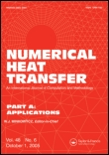
NUMERICAL HEAT TRANSFER PART A-APPLICATIONS
Exploring innovative applications in condensed matter physics.NUMERICAL HEAT TRANSFER PART A-APPLICATIONS, published by TAYLOR & FRANCIS INC, serves as a premier outlet for cutting-edge research in the domains of numerical analysis and condensed matter physics. With an ISSN of 1040-7782 and an E-ISSN of 1521-0634, this esteemed journal has steadily maintained its influence in the academic community since its establishment in 1989, continuing its publication into 2024. Currently ranked in the Q2 quartile for both Condensed Matter Physics and Numerical Analysis, it stands as a vital resource for researchers committed to advancing computational methodologies and applications. The journal's Scopus rankings reflect its growing impact, particularly in mathematics, where it is placed in the top 26% of its category. Although not an open-access journal, its comprehensive research articles and detailed applications foster innovation and collaboration, making it essential for professionals and students aiming to deepen their understanding of thermal transfer phenomena through numerical techniques. This journal not only bridges theory and application but also propels forward the field of heat transfer.

INTERNATIONAL JOURNAL OF HEAT AND FLUID FLOW
Exploring Innovations in Thermal and Fluid SystemsFounded in 1979, the INTERNATIONAL JOURNAL OF HEAT AND FLUID FLOW is a premier publication in the fields of mechanical engineering, fluid dynamics, and heat transfer, published by Elsevier Science Inc. With an impressive impact factor and ranking in the Q1 category for Mechanical Engineering and Q2 for Condensed Matter Physics and Fluid Flow and Transfer Processes, this journal is highly regarded for its rigorous peer-reviewed articles that contribute significantly to the advancement of knowledge in these critical areas. Researchers, professionals, and students can access cutting-edge studies that explore the intricacies of thermal and fluid systems, ensuring they stay at the forefront of scientific exploration. The Scopus rankings further affirm its role as a leading source of impactful research, with significant placements in crucial academic categories. Join an active community of scholars committed to innovation and excellence in the exploration of heat and fluid flow phenomena.

International Journal of Heat and Technology
Transforming Knowledge into Practical SolutionsThe International Journal of Heat and Technology is a premier academic publication dedicated to the dissemination of innovative research in the fields of thermal engineering, fluid mechanics, and condensed matter physics. Published by the INT INFORMATION & ENGINEERING TECHNOLOGY ASSOCIATION and based in Italy, this journal has been a significant resource for researchers and professionals since its inception in 1983, with a commitment to advancing knowledge until 2024. With an impact factor that reflects its relevance, the journal encompasses diverse topics within its scope, bridging gaps between theoretical research and practical applications. Although currently not open access, the journal provides valuable insights into the nuances of heat transfer, flow dynamics, and material properties, making it a critical reference for academia and industry alike. The journal's Scopus rankings position it within the competitive landscape of chemical and mechanical engineering, highlighting its contribution to advancing these fields. We invite scholars, professionals, and students to engage with the rich content provided within its pages, to foster a deeper understanding of heat and technology in our rapidly evolving world.

HEAT TRANSFER RESEARCH
Shaping the Future of Mechanical Engineering ResearchHEAT TRANSFER RESEARCH is a leading academic journal published by Begell House Inc that focuses on the dynamic and evolving fields of heat transfer, fluid flow, and mechanical engineering. With an ISSN of 1064-2285 and an E-ISSN of 2162-6561, this journal serves as a critical platform for researchers and professionals seeking to disseminate innovative findings and advancements in these interrelated disciplines. Covering converged years from 1992 to 2024, HEAT TRANSFER RESEARCH has established its impact in the academic community, achieving a 2023 ranking of Q3 in Condensed Matter Physics and Q2 in Fluid Flow and Transfer Processes. It currently occupies a percentile rank ranging from 44th to 54th across several Scopus categories, underscoring its relevance and contribution to the scientific discourse. While Open Access options are not available, the journal remains committed to providing high-quality research and insights that shape the future of thermal sciences. Accessible to both seasoned professionals and aspiring students, HEAT TRANSFER RESEARCH is indispensable for anyone looking to stay ahead in the ever-changing landscape of engineering and applied physics.
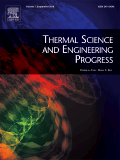
Thermal Science and Engineering Progress
Connecting researchers to the pulse of thermal advancements.Thermal Science and Engineering Progress is a premier peer-reviewed journal published by ELSEVIER, established to bridge the gap between theoretical and practical advancements within the fields of thermal science and engineering. Since its inception in 2017, this esteemed journal has rapidly ascended to a Q1 ranking in the category of Fluid Flow and Transfer Processes, positioning it among the top 17 of 96 journals in this discipline, as reflected by its impressive 82nd percentile ranking in Scopus. With a focus on disseminating high-impact research, Thermal Science and Engineering Progress aims to foster innovation and collaboration by publishing cutting-edge studies that address both contemporary challenges and future directions in thermal management, energy conversion, and heat transfer technologies. Researchers, professionals, and students alike are invited to explore the wealth of knowledge contained within its pages, which are accessible from its headquarters in Amsterdam, Netherlands. This journal plays a critical role in advancing technological progress and fostering a deeper understanding of thermal processes, making it an essential resource for anyone dedicated to these crucial areas of study.